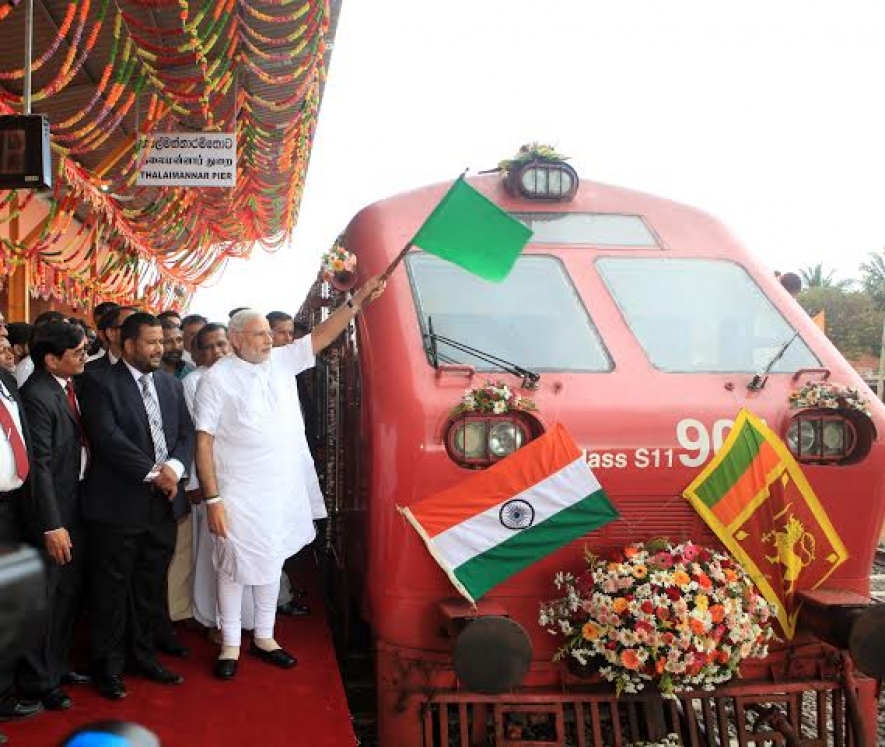Accompanied by Sri Lankan President Maithripala Sirisena, PM Modi also unveiled a plaque inaugurating Talaimannar 1650 Pier Railway station.
The newly-constructed 63-km railway track between Madhu Road and Talaimannar Pier - which is the closest point to India, is the last segment of the 265-km long, prestigious Northern Railway Line Reconstruction Project which is being executed by IRCON International Ltd., a Government of India owned company.
It was exactly a century ago during the British colonial period; on February 24, 1914 that Ceylon (Sri Lanka) created historic relations with neighbouring India by constructing a railway line up to Talaimannar to connect the train services of India and Sri Lanka via a ferry service. The relationship that was created centuries ago however ground to a halt due to LTTE terror that engulfed the entire North in 1984.
The increased terror activities by the LTTE made Mannar a distant location even for the locals in the early 1990s when terrorists blasted the Mannar railway bridge and the others along the Medawachchiya - Talaimannar line, resulting in a train journey to Mannar a pipe dream for the Southerners.
The commissioning of train services up to Talaimannar Pier which now establishes a direct train link with Colombo after a gap of more than 25 years has fulfilled the much awaited dream of the people from these parts of the country. In future this line is likely to provide a vital link to Sri Lankans vis a vis availing themselves of the ferry services for travelling to India. The excitement and happiness of the local public was amply demonstrated during the inaugural train run all along it’s route.
Project Director of the Talaimannar rail service D.K.L.P Kumara while expressing his views to www.news.lk said after the end of the hostilities in the North, the Indian government pledged a US$ 800 million line of credit at significantly concessional rates to reconstruct the Northern Railway lines completely destroyed by the Tamil Tiger terrorists. The project included reconstruction of railway lines, installation of signaling and telecom systems and the procurement of rolling stock.
He said that construction of the 106 kilometer long Medawchchiya - Thalaimannar line was carried out in two phases. In the first phase the 43-kilometer Medawchchiya to Madhu segment was constructed at a cost of US$ 81.3 million. The first phase was opened for service in May 2013.
In the second phase 63 kilometers of rail line from Madhu to Thalaimannar was reconstructed at a cost of US$ 149 million. A new pier at Thalaimannar would also be built to pave the way for resumption of ferry service between Thalaimannar and Rameswaram in India. The Indian Railway Construction Company Limited (IRCON) carried out the construction work of both stages of the project which was financed under a US$ 425 million credit facility from India.
According to the Talaimannar Station Master Sumedha Somarathna , most of the rails and sleepers have been imported from India to facilitate the project. They have been designed under Indian railway standards which are very similar to Sri Lanka standards. Three major bridges have been constructed to facilitate the project and there will be a 100 foot three span bridge, and a 100 foot two span bridge.
The Talaimannar pier is 960 feet in length. Five crossing stations and three sub-stations were set up between Madhu Road and Talaimannar.
The five main stations are Murunkan, Mannar, Pesalai, Talaimannar and the Taliamannar Pier. The other three halts are located at Manthottam, Thiruketheeswaram and Thoddaweli.
Although the track has a design speed of 120 kilometres per hour, normally a train can run at a speed of 100 kilometres per hour.Therefore, the rail track will facilitate to reach Talaimannar within one and half hours from Medawachchiya while paving the way to create closer links between India and Sri Lanka with the possibility of restarting the ferry service between India and Sri Lanka, further boosting economic and social links between the two countries. It will also provide close links with major economic hubs such as Anuradhapura, Kurunegala, Colombo, Galle and Matara.
Therefore, there is potential for the Mannar town to be developed as a modern commercial hub in Sri Lanka with close international links across the sea while giving major push for Sri Lanka and India to strengthening the relationship over the issues over the Palk Strait.
This is very good for Sri Lanka and India, and it will be a good opportunity for tourism as well. The Northern people will find that it is the shortest and the cheapest way of travelling to India and engage in trade between the two countries.
(SST/KH)




















